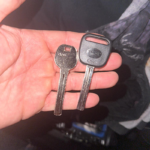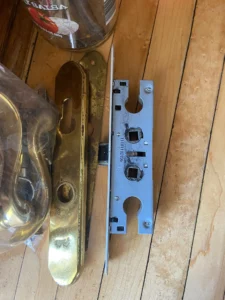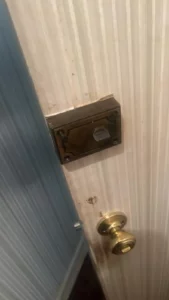Broken Keys in Locks: Proven Solutions and How to Avoid This Situation From Happening Again
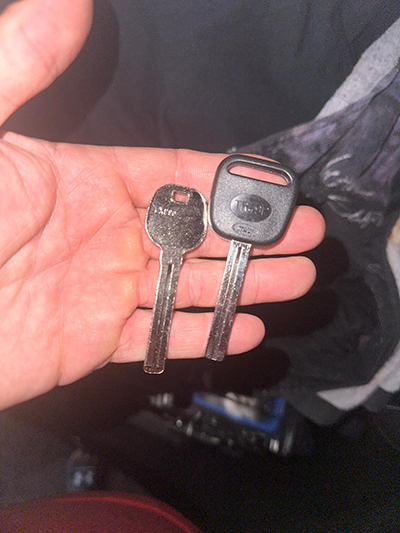
In this comprehensive guide, we’ll explore what to do when you break a key, how our professional locksmith team can successfully pull the key from a lock, the tools we use, the costs involved, if insurance covers this procedure, preventive measures you can teak to prevent this from happening again, and when it’s time to call professional help from Real Time Locksmith.
Why Do Keys Break Inside Your Lock?
Before we explore how our team can get a broken key out of your lock, let’s dive into some of the reasons for a broken key situation in the first place.
Keys break in locks for various reasons, and understanding these factors can help prevent such incidents. One common cause is applying too much force while turning the key, especially in older or rusted locks. Keys are typically made with soft metals that can easily snap a thin piece off inside the locking system.
Wear and tear over time can also weaken the key, making it more susceptible to breakage each time you push the key into the lock. Poor key quality, particularly with softer metals, increases the risk of breakage under stress. Additionally, compromised lock mechanisms or misalignments can contribute to key breakage.
Another reason a key breaks inside your lock is because of the accumulation of dirt, debris, or foreign objects within the lock. This can hinder smooth key movement, exerting additional stress on the key and making it prone to snapping. Regular maintenance, gentle handling, and awareness of these factors can significantly reduce the likelihood of keys breaking inside locks, ensuring the longevity and reliability of both keys and locks.
What To Do When You Have a Key Inside Your Lock
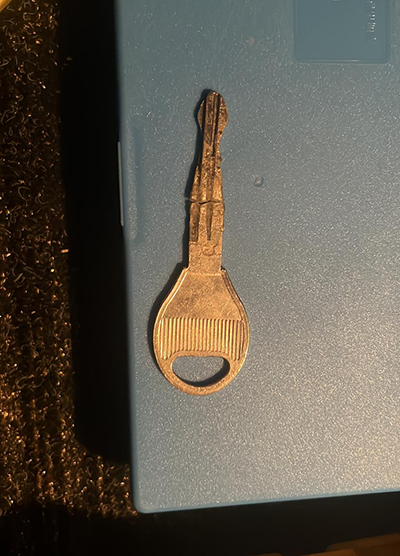
Don’t use excessive force to extract the key from a lock. Resist the temptation to push, pull, or force the key or broken piece of the key out because trying to do so can lead to more damage to the lock, making the extraction process more complex.
Examine the broken key piece carefully. If you have a portion of the key sticking out from the lock, gently pull the key fragment out using your fingers or pliers. Be cautious not to push it further into the door lock.
Do Not Use Super Glue
Contrary to popular belief, using super glue to remove a broken key or a broken piece of a key stuck in a lock is not recommended. The back and forth of push and pull using super glue often complicates the extraction process and can further damage the lock mechanism.
How Our Team Will Remove a Broken Key
When you find yourself in the unfortunate situation of a key lodged in your door lock, Real Time Locksmith becomes the go-to professional to skillfully pull the remnants without causing damage to the lock or door. Locksmiths employ various specialized tools and techniques to perform key extractions efficiently.
Key Extractor
The key extractor tool is one of the most necessary tools in a locksmith’s arsenal to get a broken key from your lock. Also called a spiral key extractor or spiral extractor, the key extractor tool features a hook on the tip that can grab the broken bit stuck inside the lock. This hook is adept at latching onto the key pieces lodged within the lock.
Our team will carefully insert the key extractor and hook to grasp the broken key and gently pull it out, navigating the intricacies of the lock’s internal mechanism. Key extractors with specialized hook tips are one of our professional locksmith team’s most commonly used tools.
Needle Nose Pliers
In cases where removing broken keys and a key piece is still visible and protruding from the lock, locksmiths may insert needle nose pliers or tweezers to grab the piece instead of key extractors to extract it. Using needle nose pliers as a tool to remove the key requires precision and dexterity to avoid pushing the key deeper into the lock or causing more harm to the lock mechanism.
Graphite-Based Lubricants
As a last resort or to help access and remove the key easily our professional locksmith team may use a graphite powder-based lubricant. More commonly used for lubricating keyways and locks, reducing friction, and minimizing the risk of key breakage, a spray lubricant can also be used to help remove a damaged key from a lock.
Removing a Broken Key From Different Lock Systems
The process of removing a broken key becomes more intricate when dealing with different or new lock systems, each requiring specific skills and tools.
Cylinder locks, commonly found in residential doors, may require a different approach from other types of locks, for example, tubular locks that are generally used in vending machines or furniture. Mortise, padlocks, and high-security locks each present their challenges, requiring locksmiths to adapt their techniques accordingly and use the right tool for the right lock.
For more complex extractions, locksmiths might use a broken key extractor kit to remove the broken key. These kits include an array of specialized tools catering to different lock types and key sizes. These kits are comprehensive and provide locksmiths with the versatility needed to handle a variety of key extraction scenarios.
In situations where the key breaks deep inside the lock or is embedded or resistant to several attempts using conventional extraction methods, locksmiths may resort to using a hacksaw or jigsaw blades. However, these tools demand an elevated level of expertise to prevent collateral damage to the lock or door.
In essence, extracting a key from a lock is a task that demands a unique set of skills and specialized tools possessed by our professional locksmiths. Their ability to adapt to different locking systems, coupled with their precise use of key extraction tools, ensures a successful resolution to the problem while preserving the integrity of the lock and door.
Using Other Tools To Remove a Broken Key From A Lock
Jigsaw and Hack Saw Blade
Locksmiths may use a jigsaw or hack saw blade to extract a broken key from a lock under specific circumstances. When the key blade is deeply embedded within the lock or the conventional extraction methods prove challenging, our team may opt for these cutting tools to remove a broken key as a last attempt.
However, this approach is typically employed as a last resort to remove a broken key due to the potential risk of damaging the lock or door. It requires a high level of expertise and precision to effectively wield a hack saw or jigsaw blade without causing collateral harm.
Our locksmiths use these saws and blades to remove the broken part of the key judiciously. We understand that their application is situational and demands careful consideration to ensure a successful key extraction while minimizing any negative impact on the overall security of the lock and door.
Lock Picks
You’ve all heard that you can use a paper clip to help get a key out of the lock cylinder? Gently push the paper clip along the side of the key and remove the broken key easily. It sounds simple, but it requires skill, patience, and an understanding of both the lock cylinder and the key. Your best bet is a skilled locksmith.
Locksmiths use lock-picking techniques to open a lock when a piece of the key is stuck inside the lock. Lock picking involves manipulating the internal components of the lock cylinder to gain entry to the lock.
In the case of a key extraction, locksmiths carefully insert specialized lock picks, a tension tool, or an extractor tool with a special tip to navigate around the obstruction caused by the broken piece. This method requires a deep understanding of lock mechanics and a deft touch to access a key inside a lock properly.
Does Insurance Cover a Key Extraction From a Lock?
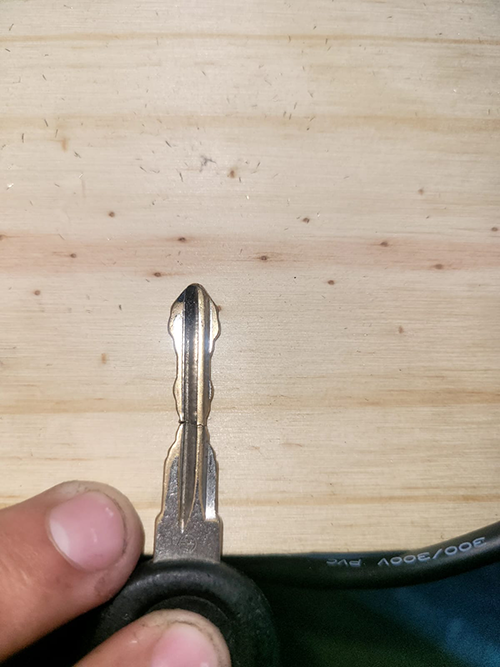
However, the coverage can vary, and it’s crucial to review your insurance policy details. If you’re unsure of what you’re covered for, talk to your insurance provider to understand the specific terms and conditions. Some insurance policies may have a deductible or limit on coverage for locksmith services, so it’s essential to be aware of these factors.
Additionally, providing documentation, such as photos or a detailed explanation of the situation, may be necessary when filing a claim. Ultimately, checking your insurance policy and consulting with your insurance provider will provide clarity on whether the removal of a key from a lock cylinder by locksmiths is covered under your specific coverage.
When Is It Time to Call Real Time?
If you’ve attempted the initial steps of assessing and gently trying to extract the broken pieces of your key without success, it’s time to call Real Time. Our professional locksmiths possess the expertise, technology, and experience necessary to navigate complex extractions without causing further damage to your lock.
Dealing with a broken key in a lock can be a stressful experience, but understanding the appropriate steps and seeking professional assistance when needed can make the process smoother. Regular maintenance and awareness of preventive measures can go a long way in avoiding the inconvenience of broken pieces of keys.
Always remember that our qualified locksmiths are your ally in resolving these situations efficiently and preserving the integrity of your locking system for years to come.

